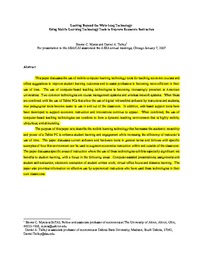Looking Beyond the Whiz-bang TechnologyUsing Mobile Learning Technology Tools to Improve Economic InstructioniD
Steven C. Myers, Daniel A. Talley
Publikationsdatum:
|
 |
 Diese Seite wurde seit 7 Jahren inhaltlich nicht mehr aktualisiert.
Unter Umständen ist sie nicht mehr aktuell.
Diese Seite wurde seit 7 Jahren inhaltlich nicht mehr aktualisiert.
Unter Umständen ist sie nicht mehr aktuell.
 Zusammenfassungen
Zusammenfassungen
This paper discusses the use of mobile computer learning technology tools for teaching economic courses and
offers suggestions to improve student learning outcomes and to assist professors in becoming more efficient in their
use of time. The use of computer-based teaching technologies is becoming increasingly prevalent at American
universities. Two common technologies are course management systems and wireless network systems. When these
are combined with the use of Tablet PCs that allow the use of digital ink-enabled software by instructors and students,
new pedagogical tools become easier to use in and out of the classroom. In addition, web-based support tools have
been developed to support economic instruction and innovations continue to appear. When combined, the use of
computer-based teaching technologies can combine to form a dynamic teaching environment that is highly mobile,
ubiquitous, and stimulating.
The purpose of this paper is to describe the mobile learning technology that harnesses the academic versatility and power of a Tablet PC to enhance student learning and engagement while increasing the efficiency of instructor’s use of time. The paper discusses current software and hardware tools in general terms and follows with specific examples of how this environment can be used to augment economics instruction within and outside of the classroom. The paper discusses specific areas of instruction where the use of these technologies exhibits especially significant net benefits to student learning, with a focus in the following areas: Computer-assisted presentations, assignments and student self-evaluation; electronic evaluation of student written work; virtual office hours and distance learning. The paper also provides information on effective use by experienced instructors who have used these technologies in their own classrooms.
Von Daniel A. Talley, Steven C. Myers im Text Looking Beyond the Whiz-bang Technology (2007) The purpose of this paper is to describe the mobile learning technology that harnesses the academic versatility and power of a Tablet PC to enhance student learning and engagement while increasing the efficiency of instructor’s use of time. The paper discusses current software and hardware tools in general terms and follows with specific examples of how this environment can be used to augment economics instruction within and outside of the classroom. The paper discusses specific areas of instruction where the use of these technologies exhibits especially significant net benefits to student learning, with a focus in the following areas: Computer-assisted presentations, assignments and student self-evaluation; electronic evaluation of student written work; virtual office hours and distance learning. The paper also provides information on effective use by experienced instructors who have used these technologies in their own classrooms.
 Dieser Text erwähnt ...
Dieser Text erwähnt ...
 Dieser Text erwähnt vermutlich nicht ...
Dieser Text erwähnt vermutlich nicht ... 
 Nicht erwähnte Begriffe | Bildung, Blackboard, Digitalisierung, Kinder, LehrerIn, Unterricht |
 Tagcloud
Tagcloud
 Zitationsgraph
Zitationsgraph
 Zitationsgraph (Beta-Test mit vis.js)
Zitationsgraph (Beta-Test mit vis.js)
 Volltext dieses Dokuments
Volltext dieses Dokuments
 |  Looking Beyond the Whiz-bang Technology: Artikel als Volltext ( Looking Beyond the Whiz-bang Technology: Artikel als Volltext ( : :  , 141 kByte; , 141 kByte;  : :  2021-03-21) 2021-03-21) |
 Anderswo suchen
Anderswo suchen 
 Beat und dieser Text
Beat und dieser Text
Beat hat Dieser Text während seiner Zeit am Institut für Medien und Schule (IMS) ins Biblionetz aufgenommen. Beat besitzt kein physisches, aber ein digitales Exemplar. Eine digitale Version ist auf dem Internet verfügbar (s.o.). Es gibt bisher nur wenige Objekte im Biblionetz, die dieses Werk zitieren.









 Computer
Computer distance learning / Fernunterricht
distance learning / Fernunterricht Learning Management System (LMS) / Lernplattform
Learning Management System (LMS) / Lernplattform Lernen
Lernen Notebook
Notebook OneNote
OneNote Schule
Schule Tablet PC
Tablet PC Wireless Computing an Schulen
Wireless Computing an Schulen WLAN / Wireless LAN
WLAN / Wireless LAN

 Biblionetz-History
Biblionetz-History